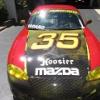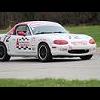From the picture, it is apparent the spline'd shaft at time of failure was not engaged into the female CV joint splines any deeper than the button end itself resulting in all of the torque being transmitted to the outer CV joint through only this small button shaped end piece. This resulted in the pure torsional (twist) failure/separation pictured at the stress riser groove machined for the shaft retaining clip.
Had the spline'd shaft been fully engaged into the female CV joint splines per design, the button portion of the shaft would not receive any torsional (twist) load application due to the button end being beyond the female CV joint splines once the lock clip passed through splines to the point where expands for the purpose of preventing the shaft from disengaging the CV joint female splines. In the design position, there would be no way for the button to be twisted off the end of the shaft through the clip grove.
There are a number of possible contributors to this failure;
a.) The shaft may never have been installed any deeper than the depth of the button.
b.)The shaft may have been installed deeper than just the button but not deep enough to allow the clip to expand.
c.) The clip may have been missing, wrong or defective preventing it from performing its function.
d.) The female spline'd CV inner race may have been installed backward so the relieved side intended for ring expansion was facing the wrong side of the CV joint, (I have not confirmed that this can be done- just a supposition)
Either b, c) or d) could result in potential for the shaft to be extracted during vehicle operation from the CV joint female splines to the point of only engagement of the button portion of splines resulting in the shaft being engaged as in condition a) which is required for this failure.
Rich Powers
SM 145-Arizona
 Half Shaft1.JPG 181.1KB
11 downloads
Half Shaft1.JPG 181.1KB
11 downloads Half Shaft2.JPG 148.38KB
8 downloads
Half Shaft2.JPG 148.38KB
8 downloads



 Sign In
Sign In Create Account
Create Account









 Back to top
Back to top Report
Report



















